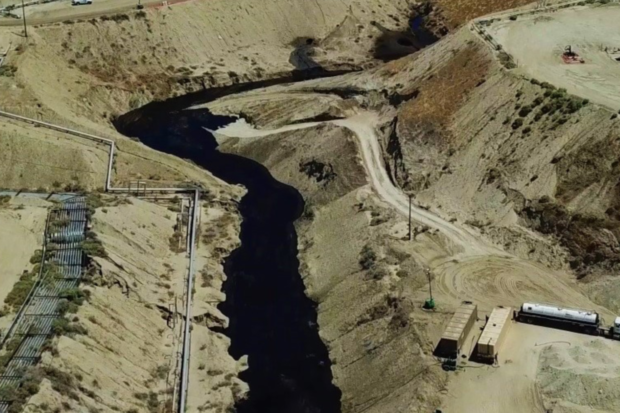
By Tom Frantz
California’s 140-year-old oil company, Chevron, has been in the spotlight recently in Kern County. It is not good news. Chevron is in the process of losing a significant chunk of the Kern River Oil Field to the City of San Francisco, and Chevron recently caused the biggest oil-related spill in California since 1969 in Santa Barbara.
The Kern River Oil Field contains a parcel of land owned by San Francisco. The city leased its mineral rights to Chevron many years ago. Now, the city is telling Chevron that it will not renew the lease when it expires in 2020. The 82 operating oil wells on the property will have to be shut down and removed.
San Francisco residents, in the face of global warming, do not want anything to do with the production of fossil fuels. The city is actually giving up about $300,000 per year in royalties. This is not a big deal when you have a city budget of about $13 billion per year.
The land might become a protected habitat for endangered species. It is about 800 acres in size. It is inaccessible by the general public because Chevron has control of all the access roads.
One issue remains. The 82 wells need to all be plugged with cement. The cost could be somewhere near $5 million. Chevron should be responsible for cleaning up its mess, but the courts might have to decide who ultimately pays. Chevron, by the way, has net annual profits greater than San Francisco’s budget.
The oil spill, which is what the state officially calls it, happened about 40 miles west of the Kern River Oil Field. It is in the Cymric Oil Field near the town of McKittrick.
The Cymric and Kern River oil fields are similar in their production methods. The crude oil is so heavy that massive steam injection is necessary to warm it up to the point where it will flow. Giant boilers burn natural gas to make this steam.
There is a common calculation used in oil field production that measures the ratio of energy produced to the amount of energy used. An example: In the early days of Kern County oil production, 100 barrels of oil could be produced from one barrel worth of energy. This ratio is sometimes abbreviated EROI (Energy Returned on Investment).
Today, because of the increasingly large steam operations, only 3–6 barrels of new energy is produced from the equivalent of one barrel of oil. That ratio is about equal to tar sands oil production in Alberta, Canada. This only makes economic sense because the oil produced is more valuable than the natural gas on a per unit of energy basis.
Oil production in places such as Saudi Arabia and Norway has far better 40:1 ratios. Iraq is more than 80:1. U.S. oil production averages 10:1, and Kern County is closer to 5:1, maybe even less.
California oil producers claim they follow the strictest environmental rules in the world. But in terms of total pollution per barrel of oil produced, Kern County is one of the dirtiest oil production regions in the world due to all the energy burned to produce a gallon of usable fuel.
Back to Chevron’s oil spill. What happened is the company overpressurized the underground oil with steam injections. The hot oil and briny, toxic associated water found its way to the surface either through old, improperly abandoned oil wells or simple ground fissures. This area is riddled with up to 30 oil wells per acre. Fluids spilled on the ground so far total more than 1.3 million gallons.
To make matters worse, this spill took place in a natural stream bed that coursed through the oil field. The stream bed is dry except during storms, but it has a sandy bottom that allows the fluids to slowly percolate down the slope about four miles to the plain below where farmers pump groundwater to irrigate crops.
There are several endangered species that live in the general area of the spill, especially in relatively undisturbed areas such as this stream bed, which was covered in natural vegetation. Photographs show small animal trails leading down the sides of the gully and into the pool of oil and toxic fluids.
Kit foxes, antelope squirrels, kangaroo rats, burrowing owls and the blunt-nosed leopard lizard are all likely to have homes that have been ruined by this oil spill. The California Department of Fish and Wildlife ironically claims that no harm to life is visible.
The cleanup of crude oil, which first floats steaming hot on the briny water and then solidifies on the surface of the stream bed, is being done by making roads into the gully, totally destroying the vegetation and critter homes not already soaked in oil. Much of the toxic water has soaked into the sand leaving stains on the sides of the gully and future generations to deal with downstream.
Will Chevron be fined? That is an open question. Paying for the cleanup is already costly for the company. Soil that has been dumped into the oil plus contaminated stream bed sand is apparently being scooped up and taken to a nearby hazardous waste dump.
Chevron was definitely negligent and should be fined millions of dollars. We will see what the state attorney general has in mind once things settle down.
*****
Longtime clean air advocate Tom Frantz is a retired math teacher and Kern County almond farmer. A founding member of the Central Valley Air Quality Coalition (CVAQ), he serves on its steering committee and as president of the Association of Irritated Residents. The CVAQ is a partnership of more than 70 community, medical, public health and environmental justice organizations representing thousands of residents in the San Joaquin Valley unified in their commitment to improving the health of Californians. For more information, visit www.calcleanair.org.
